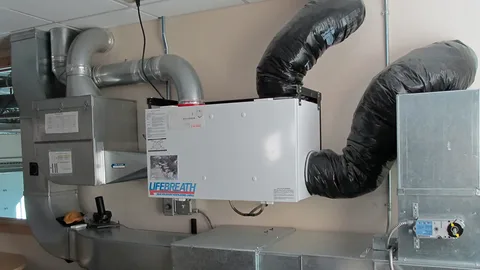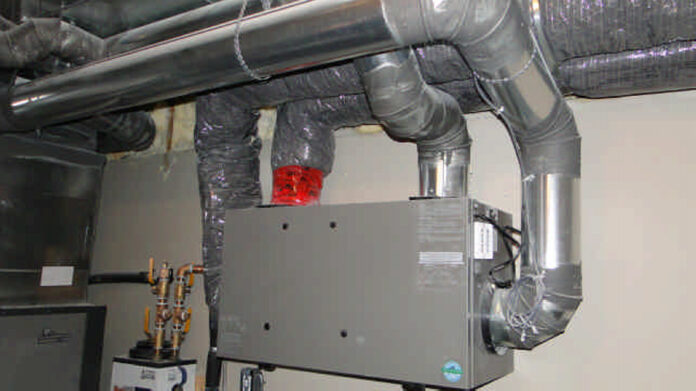In today’s world, maximizing energy efficiency is crucial. One of the best ways to achieve this is using an HRV heat recovery ventilator. This innovative system not only helps in reducing energy consumption but also improves indoor air quality. In this blog post, we will explore the various aspects of HRV heat-recovery ventilators, including how to choose the best one, the benefits of installation, and the difference between HRV and ERV systems.
Understanding the Basics of HRV Heat-Recovery Ventilator
An HRV, or heat-recovery ventilator, operates on a simple yet effective principle to maintain indoor comfort and air quality. At its core, the system utilizes a heat exchanger to transfer heat between two separate air streams—fresh air coming into a building and stale air being expelled. Unlike traditional ventilation methods that may lead to significant energy loss, the HRV system recovers most of the heat from the outgoing air before it’s exhausted outside. This recovery process is made possible through the heat exchanger, where the outgoing indoor air warms the cooler incoming outdoor air during colder months.
The process can reverse in warmer seasons, removing excess heat from incoming air. This mechanism allows for a continuous supply of fresh air, reduced energy costs, and an overall more efficient way to maintain indoor air temperature without compromising air quality. Crucially, the HRV system achieves this while keeping both air streams separate, ensuring that the incoming fresh air is not contaminated by pollutants or odors from the outgoing air.
How to Choose the Best Heat Recovery Ventilator?
Selecting the best heat recovery ventilator (HRV) requires careful consideration of several pivotal factors beyond merely the size and climate compatibility mentioned earlier. It is crucial to evaluate the unit’s heat recovery efficiency rate, as higher efficiency rates indicate superior performance and more significant energy savings. Pay attention to the system’s airflow capacity, which should match the ventilation needs of your space to avoid under or over-ventilation. The noise level is another essential factor; for comfort, opt for a quiet unit, mainly if it will be installed near living or working areas.
Consider the ease of maintenance and availability of replacement filters or parts, as these aspects will impact the long-term usability and cost-efficiency of the system. The warranty and support offered by the manufacturer can provide peace of mind and protection for your investment. By thoroughly assessing these criteria, you can ensure the selection of an HRV system that best aligns with your specific requirements, thereby optimizing indoor air quality and energy efficiency in your space.
HRV vs. ERV: Knowing the Difference
The distinction between heat-recovery ventilators (HRVs) and energy-recovery ventilators (ERVs) is pivotal for homeowners and building managers who are deciding on the best system to enhance indoor air quality and energy efficiency. While both systems aim to maintain comfortable indoor environments through efficient ventilation, their core functionalities cater to different needs based on specific humidity levels and climate conditions.
HRVs focus exclusively on heat exchange, transferring warmth from the exhaust air to the incoming fresh air during colder months and vice versa during warmer seasons. This mechanism effectively reduces the need for additional heating or cooling, making HRVs suitable for areas with extreme temperature variations but without significant humidity concerns. On the other hand, ERVs extend the functionality of HRVs by also managing humidity levels.
They can transfer moisture along with heat, which helps maintain optimal indoor humidity. This feature is especially beneficial in climates where the air is too humid or dry. In damp conditions, ERVs reduce the moisture content of incoming air, mitigating the potential for mound growth and maintaining comfort without overburdening air conditioning systems. Conversely, they help retain moisture within the indoor air in dry climates, preventing overly dry conditions that can cause irritation and discomfort.
The Benefits of Installing a Heat Recovery Ventilator
Embracing the advantages of installing a heat recovery ventilator (HRV) system transcends essential energy savings, unfolding into numerous benefits that impact wellness and operational costs:
- By enhancing indoor air quality, HRVs significantly reduce the levels of pollutants and allergens, fostering a healthier environment for occupants. This particularly benefits individuals with allergies or respiratory issues, as it ensures a constant supply of fresh, filtered air.
- The HRV system’s ability to recover heat from exhaust air means that heating and cooling systems work less strenuously, extending their lifespan and reducing maintenance expenses.
- The reduced need for conventional heating or cooling contributes to lower utility bills, marking a financial advantage that accumulates over time.
By balancing humidity levels, HRVs also prevent condensation and mound formation, safeguarding the building structure and contributing to a comfortable living space. Integrating such a system reflects a commitment to environmental stewardship, reducing carbon footprint through decreased energy consumption. This aspect aligns with sustainability goals and enhances the property’s value by meeting the growing demand for energy-efficient homes and buildings.
Top Features of the Best HRV Systems
In pursuing sustainable living, HRV systems offer an ideal solution for maintaining a comfortable indoor environment without compromising energy efficiency. Incorporating these units into your home ventilation design can result in significant savings on utility bills while contributing to a more sustainable future. Moreover, the advanced filtration system enhances the quality of air you breathe, contributing to better overall health and well-being.
High Heat Recovery Efficiency
The hallmark of the best HRV systems is their ability to achieve a high rate of heat recovery efficiency. This means they can transfer a significant amount of heat from the outgoing stale air to the incoming fresh air, minimizing energy loss and reducing the need for additional heating or cooling.
Low Energy Consumption
Optimal HRV systems are designed to operate with minimal energy usage. Their motors and fans are engineered for maximum efficiency, which ensures that the system contributes to overall energy savings while maintaining adequate ventilation.
Advanced Filtration
Top-tier HRV units have advanced filtration capabilities to remove pollutants, allergens, and even more minor particulate matter from incoming air. This feature is crucial for maintaining healthy indoor air quality, especially in urban areas or regions prone to wildfires.
User-Friendly Controls
The best HRV systems offer intuitive controls that allow users to adjust settings according to their preferences and needs easily. These systems provide flexibility and convenience for optimising indoor air conditions, whether through simple manual controls, sophisticated digital interfaces, or smart home integration.
Durability and Warranty
Superior HRV systems are built to last and constructed from high-quality materials that can withstand the rigors of continuous operation. Furthermore, reputable manufacturers back their products with comprehensive warranties, ensuring long-term reliability and peace of mind for homeowners.
Energy Recovery Ventilator: A Close Ally
While HRV systems are adept at managing temperature by transferring heat, energy recovery ventilator (ERV) brings an additional layer of functionality by managing the moisture levels in the air. This dual-action capability makes ERVs especially valuable in environments where humidity control is as crucial as temperature regulation. By capturing moisture from the outgoing air and transferring it to the incoming fresh air, ERVs can effectively maintain comfortable humidity levels inside, regardless of the season.
This not only enhances indoor air quality by preventing conditions that are too dry or too moist but also optimizes the efficiency of the heating and cooling systems by reducing the load on them. Integrating an ERV with an HRV system can lead to a more comprehensive approach to ventilation, particularly in areas where the climate fluctuates between being excessively humid or dry. This synergy ensures a balanced indoor environment and contributes to energy conservation, highlighting the significance of considering an ERV as a complement to HRV installations for a holistic ventilation solution.
Installation Tips for HRV and ERV Systems
Embarking on installing HRV or ERV systems requires thoughtful planning and precise execution to ensure their peak performance. Engaging with a certified HVAC technician who is well-versed in the specificities of these systems is imperative. They can offer valuable insights into the optimal placement of the system and the layout of ductwork, crucial elements that influence the effectiveness and efficiency of the ventilation.
Consideration of your home’s or building’s architecture is essential, as it impacts the installation process and the system’s integration with existing HVAC systems. A professional assessment can determine the most strategic locations for vents and units to maximize air distribution and recovery capabilities. During installation, it’s also vital to account for easy access to the units for future maintenance or filter replacement, ensuring that the systems operate at their best long after the initial setup.
Proper insulation around ductwork can minimize energy loss, enhancing the system’s efficiency. For those incorporating these systems into older buildings, a thorough evaluation of the current ventilation and air exchange rates will guide the customization of the HRV or ERV system to meet the space’s specific needs. By adhering to these installation tips and leveraging professional expertise, homeowners and builders can confidently install HRV and ERV systems to deliver optimal air quality and energy efficiency.
Choosing the Best Energy Recovery Ventilator
Navigating the selection of the best energy recovery ventilator (ERV) involves understanding your unique environmental and spatial requirements. The ideal ERV should boast a high-efficiency rating, ensuring it can effectively transfer heat and moisture to optimize indoor air quality and comfort while conserving energy. Ventilation rate flexibility is another critical factor; the system must be capable of adjusting to your specific volume needs to prevent under or over-ventilation, which could compromise efficiency and air quality.
Intelligent controls are increasingly becoming a must-have feature, offering the convenience of adjusting settings remotely and integrating with other home automation systems for a streamlined experience. It’s also essential to consider the unit’s noise level, maintenance requirements, and the manufacturer’s warranty, which collectively contribute to the long-term satisfaction and performance of the ERV system. Engaging with a seasoned HVAC professional can provide invaluable guidance through the selection process, ensuring that your chosen ERV effectively meets current and future ventilation needs.
Conclusion
Adopting HRV heat recovery ventilator and ERV systems is a forward-looking approach to enhancing energy efficiency and air quality. By integrating these technologies, buildings can maintain environmental and health standards through improved ventilation. The choice between HRV and ERV depends on specific climate needs and air quality objectives. Expert installation and upkeep are crucial for optimal function and to support a better living or working space by ensuring energy conservation and a healthy indoor environment. HRV and ERV stand as pivotal elements in sustainable building design.
FAQs
Q: How does an HRV differ from an ERV regarding function?
A: The critical difference lies in their capabilities; HRVs are designed to exchange heat, while ERVs can exchange heat and moisture between indoor and outdoor air streams, making ERVs suitable for areas with more significant humidity concerns.
Q: In what ways do HRV systems contribute to a home’s energy efficiency?
A: HRV systems enhance energy efficiency by recovering heat from the exhaust air and using it to warm or cool incoming fresh air, depending on the season. This process reduces the need for additional heating or cooling, leading to lower energy consumption.
Q: Can I retrofit my current home with a heat recovery ventilator system?
A: Absolutely. While the installation process might vary depending on a home’s specific layout and existing HVAC systems, heat recovery ventilator can be integrated into most homes. Consulting with a certified HVAC professional is crucial to ensure the installation effectively meets your home’s ventilation needs.
| Other Good Articles to Read |
| Blogs Rain |
| Cme Blog Spot |
| Garcias Blogs |
| Yyc Blogs |
| Blogs-Hunt |
| Impact-Blog |
| Smarty Blogs |
| Ed Blog |
| Mo Blogs |
| Blogs Em |
| Blogs T |
| Related Business Listings |
| Contact Directory |
| Local Business Profiles |


